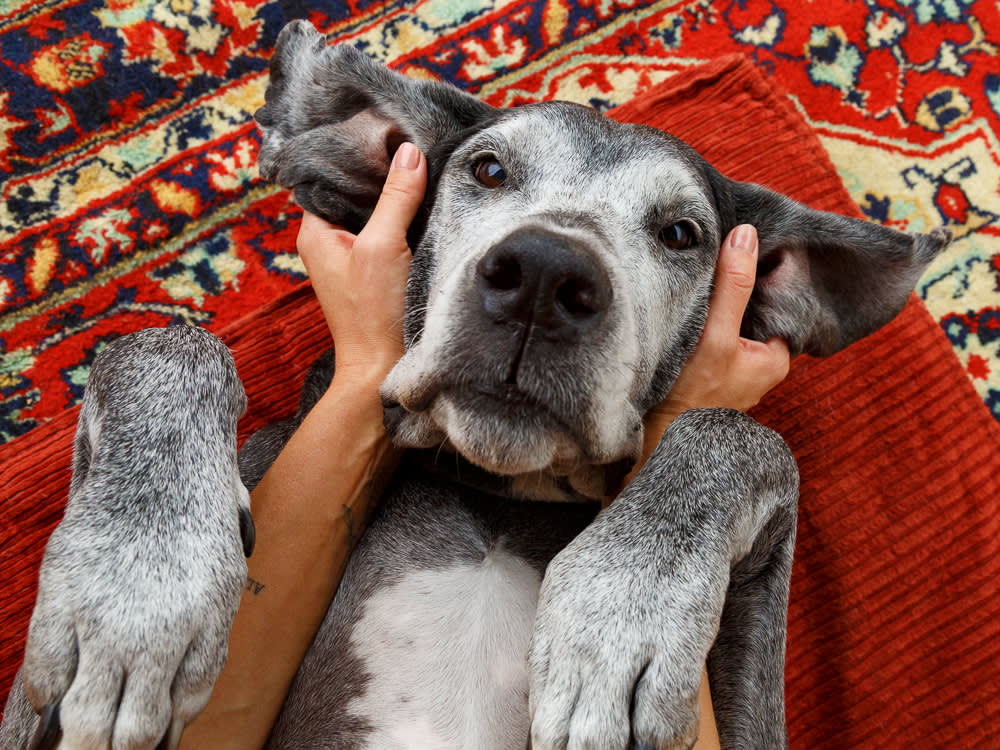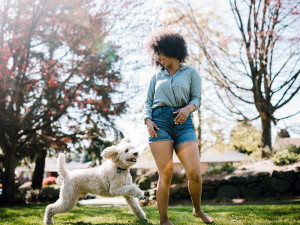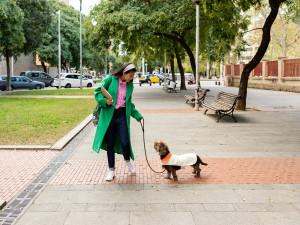How to Train and Communicate with a Deaf Dog
But first, how to spot the early signs of hearing loss.

share article

Your pet wants you to read our newsletter. (Then give them a treat.)
There’s a brief moment in the iconic 1967 movie, The Graduate, that helps me imagine what life is like for my 15-year-old Corgi, Edgar, who has lost most of his hearing. Early in the film, Benjamin Braddock, the eponymous graduate, enters a pool party given by his parents in his honor, wearing full scuba gear. While he can see guests’ mouths moving and read their facial expressions, all he can hear inside the diving mask is the sound of his own breathing.
Every now and then, I look Edgar straight in the eye and say, “Plastics.” That’s the advice given to Benjamin by the soon-to-be-cuckolded Mr. Robinson about a possible career path. No one ever laughs at my jokes, so Edgar’s blank look is not new, but it makes me feel as though I am still communicating with him even though he cannot hear. It might seem petty to worry about his deafness when Edgar is in otherwise perfect health. But I realized that his deafness was a barrier to our bond, and that I felt as estranged from him as he undoubtedly did from me. He had never come when he was called, so that was nothing new. But suddenly he looked away when I said the various trigger words — “Let’s go for a walk,” “Do you want a treat?” “Do you want to ride in the car?” — that used to cause him to cock his head from side to side in a manner that made it clear we were communicating.
Signs of Hearing Problems with Your Dog
If your dog experiences the following, it could be a sign of deafness or another ear condition that should be evaluated by your veterinarian:
Inattentiveness or change in obedience
Inability or confusion when following familiar vocal commands
Prolonged barking
Difficulty waking up
Repetitive head shaking or tilting toward side of affected ear
Painful ears or smelly discharge from ears
Change in personality
Causes of Dog Hearing Loss
Dogs’ hearing mechanism is basically the same as that of humans, and they experience hearing loss for many of the same reasons: they can be congenitally deaf (deaf since birth), or they can acquire deafness due to having dirt, wax, ear mites, or other foreign bodies in the ear; an infection or inflammation of the ear canal; trauma to the head; noise trauma; exposure to certain antibiotics or other drugs; or old age. I do not know when or why Edgar lost his hearing — part of it was undoubtedly just part of the normal aging process.
But he also had an ongoing skin infection that extended into his ears, which I treated with antibiotics, either of which can cause hearing loss. His hearing seemed to have deteriorated overnight, but most likely, it was a gradual process that I didn’t notice until he exhibited some of the more obvious symptoms: pacing around looking for his people, suffering obvious distress at being left alone, exhibiting a pronounced startle response at being touched while he was asleep.
Training a Deaf Dog
“In hearing, as in most other things, dogs are very adaptive and good at compensating,” says Dr. Colette Williams, DVM and electro-diagnostician at the University of California at Davis, Pritchard Veterinary Medical Teaching Hospital. Among many other tests that she conducts, she assesses animals for hearing loss using brainstem auditory evoked response (BAER) technology. Many seeking her expertise are breeders, who use BAER to identify congenital deafness in their puppies.
Dr. Williams has tested thousands of dogs and has owned two deaf dogs of her own. One of her dogs, a deaf-from-birth Dalmatian, learned hand signals that Dr. Williams created. “The key was consistency, and rewarding him with treats,” she says. “I had another dog who could hear at the time, and he was harder to train than the deaf dog.” Hearing dogs often aid a deaf dog, Dr. Williams points out. They give social cues and can help with training. Like Edgar has had to do, Williams’ deaf dog accepted his condition and got on with life. “Dogs don’t have the self-pity that a lot of people have.”
Seattle-area dog trainer Diane Rich, who has worked with numerous deaf dogs over the past 25 years, points out the importance of developing other modes of communication regardless of whether your dog is deaf or has tip-top hearing. She teaches people to use a combination of body language, hand signals, and auditory cues. That way, if the dog loses hearing in old age, they won’t feel quite as isolated. “People want to keep up communication with an older dog,” she says. “It takes a lot of patience. You have to learn how to communicate differently, not just verbally.”
Rich also recommends teaching all puppies a “watch” command in addition to the usual commands. Hold some alluring food near the dog’s nose and slowly bring it to your eye level, maintaining eye contact with the dog. Say “Watch” or “Look.” Work on “fading the lure,” and eventually, you’ll be able to just point to your eye and have the dog’s full attention. “Dogs use an array of body language already,” says Rich. “People need to be able to use their own body language to communicate with their dog.”
While some people teach their deaf dogs American Sign Language, any hand signal will do, as long as you’re consistent. “There’s no ceiling to how many words or signs a dog can learn,” says Rich. “They can learn as long as they have a pulse and you have motivation and patience. If you make training fun, they’re going to love learning, and it’s going to cement your bond.” She points out that it’s not true that you can’t teach an old dog new tricks: sometimes it’s easier to train older dogs because they have longer attention spans.
Living with a Deaf Dog
Instead of feeling bad for your pup, take a matter-of-fact approach to your deaf dog’s disability. “Dogs aren’t saddled with ego,” she says. “If we pity them, we can create a situation where the dog may either shut down or act out because they think they did something wrong to make us feel bad. If you act like the disability isn’t a big deal, dogs will respond like it’s not a big deal.”
Every day, Edgar and I practice the hand signals we learned in puppy class 15 years ago, which he still remembers: come, sit, stay, down, good boy. I smile a lot and pat him while giving the “thumbs up” sign when he does something well. I continue to tell him my jokes and he continues to give me a blank look, just like he always has. Though he requires a lot of extra care for all his special needs, it is care I am happy to provide in gratitude for the happiness he has brought me. In short, even though he has lost his hearing, arthritis has slowed him down, he sleeps most of the day and cannot participate fully in all of our old antics, he is still my best friend, and encroaching old age will never change that.
Tips for Living with a Deaf Dog
Keep your deaf dog on a leash or in a fenced yard. Deaf dogs cannot hear cars and other hazards.
Learn to communicate using hand signals. Essential signals are: sit, stay, come, down, good, no, and watch. Also establish a signal for your dog’s name.
Buy a tag for your dog’s collar that says: “Sparky is deaf…” in addition to your contact info.
Place a bell on your dog’s collar so you can find them.
Use a flashlight to signal to your dog that you want their attention.
Be consistent in your communication.
Let your dog know when you are leaving the house. Do not “disappear” when they are asleep.
Wake a deaf dog by putting food under their nose, or by touching them away from their face. Teach children how to wake a deaf dog without startling them. Some dogs may bite if startled when they are sleeping.
Diagnosing a Deaf Dog: The BAER Test
Think your dog might have hearing loss but aren’t sure? BAER opens in a new tab(Brainstem Auditory Evoked Response) is a diagnostic test for hearing whereby a dog is fitted with earphones that extend into the ear. The device emits a sound and the response is detected by tiny electrodes that have been placed on the dog’s head and shoulders. The BAER detects electrical activity in the cochlea of the ear and the auditory pathways of the brain, much like an EKG detects electrical activity in the heart. The resulting waveform definitively shows the degree of a dog’s hearing loss. The procedure is painless, but some dogs might object to wearing earphones. Results are available on the spot.
While curious pet parents sometimes seek confirmation of a hunch that their dog is deaf, BAER testing is used routinely by breeders, primarily those whose breeds are susceptible to congenital deafness. Coat-color-related deafness is common among some white-coated and merle breeds, such as Dalmatians and Australian Shepherds. (To find out which breeds are most affected, see Louisiana State University’s Dr. George M. Strain’s comprehensive listopens in a new tab.) Deaf puppies may play harder than their littermates because they cannot hear the yelps they inflict. They may also be hard to wake or struggle to follow cues from the other puppies.
Those who train working dogs also utilize BAER testing. These dogs need to be able to hear in both ears in order to localize the source of a sound. (A dog can be unilaterally deaf — deaf in one ear — so that they can still hear but cannot tell where the sound is coming from.) Others, whose dogs experience chronic ear infections, turn to BAER testing to find out how much hearing loss may have been caused by an ear infection. BAER testing is also used to aid in the diagnosis of more serious medical conditions, such as vestibular (inner ear) disease or brain tumors.
BAER testing can be done only at one of the centers that specialize in the test. Click hereopens in a new tab for a list of BAER testing sites.
Dana Standish
Dana Standish lives in Seattle.
Related articles
![A woman with curly black hair playing with her white labradoodle dog outside]() opens in a new tab
opens in a new tab7 Games That Can Actually Teach Your Dog Something
Cue the Schoolhouse Rock! because learning can be fun.
![Two boxer dogs playing with a ball together in the park]() opens in a new tab
opens in a new tabDocked Tails Play a Role in Dog Communication
Looks aren’t everything, but they can talk.
![Trendy woman in a green coat walking her cute dog in a white jacket in public]() opens in a new tab
opens in a new tab6 Reasons to Set Boundaries for Your Dog
Well-trained dogs have more freedom (and more fun).
![Angry pomeranian chihuahua pup on a dark gray background]() opens in a new tab
opens in a new tabIs Your Dog Giving You the Stink Eye?
Despite plenty of reasons to get mad, an animal behaviorist says dogs rarely express real anger.





